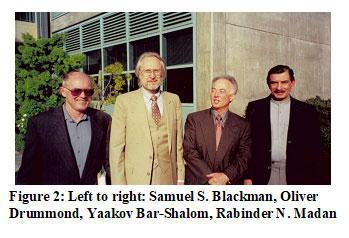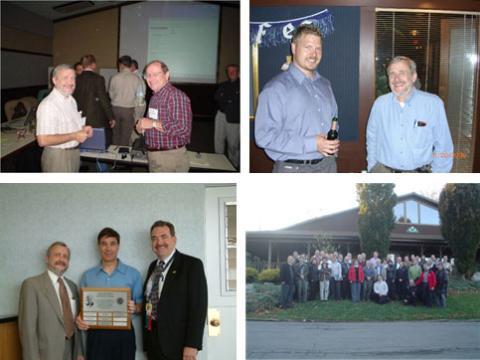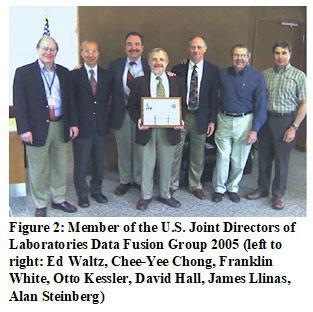
-

Oliver Drummond
-Oliver Drummond was a dear friend and colleague to all in the tracking and data fusion community. He had a long career of outstanding accomplishment in industry and in the development of theoretical methods. He received a PhD from University of California in Los Angeles and went on to have a long distinguished career in industry, where he worked for The Aerospace Corporation, Hughes Aircraft Company, and General Dynamics. He later became a valued consultant for numerous government agencies.
His papers and lectures helped us all to better understand basic concepts and to develop practical solutions to difficult problems. He published over 50 papers and lectured throughout the world and the US. His tireless efforts as chairman of the SPIE conference “Signal and Data Processing of Small Targets" from 1989 through 2015 provided a great service as it brought together researchers and practitioners from all over the world to exchange ideas and methods. He was well known for his humor and insight.
Oliver's sense of humor really blossomed in conference sessions when a few of his peers were present. Developing a technology does involve friendly discussions and he was right at home in that environment. A lot of useful discussion went on even with the humorous portions. He was both humble in his comments to presenters and generous with his compliments. Many people attended the conference sessions to learn, but many wanted to hear his take on a particular algorithm and/or concept. Oliver left a legacy that included the conference that he chaired for 27 years, the technology that he developed and wrote about, and the insight that he provided to help us all to develop better solutions to practical problems. He will be sorely missed but his work will live on.

On behalf of the ISIF Community

Otto Kessler
-Otto Kessler was one of the founders of the Joint Directors of Data Fusion Laboratories (JDL). He has contributed over 50 years into the fields of radar and data fusion at NADC, ONR-Europe, DARPA, and MITRE Corp. and has a key role in creating fusion communities globally.
Otto used every opportunity to coach the next generation fusion researchers in both academic and social interactions, emphasizing the most challenging aspects that require focus and attention in collaboration with his peers that established the JDL with him.
He had enduring commitment to his family, his work, and his colleagues. Most of all, he is remembered for his insistent confrontation with what was wrong and might be put right, and his fighting spirit that lasted to the end of his days.

Submitted by Elisa Shahbazian

David L. Hall
-Dave completed his undergraduate studies at the University of Iowa in just three years with dual major in Physics and Mathematics. He completed his Masters of Science in Astronomy from Penn State University (PSU). During a time when many of his classmates were seeking education deferments, Dave interrupted his graduate studies to serve his country, spending four years in the U.S. Air Force during the height of the Vietnam War.
Dave earned a PhD in Astronomy from PSU. Beginning in 1976 and for some twenty-five years thereafter Dr. Hall supported the research, development, and application of data fusion processes and products across the scientific community and industry. This time included stints at MIT Lincoln Labs, Computer Sciences Corporation and HRB Systems. Dave returned to Penn State in 1993 as the Associate Director of the PSU Applied Research Laboratory (ARL). In the same year he founded Tech Reach, Inc. At ARL Dave provided technical leadership and strategic direction to some 150 scientists and engineers conducting research in signal processing, intelligent sensors, information science and technology, automated reasoning and the control of complex systems.
In 2001, Dave answered another calling; this time joining the ranks of a nascent PSU College of Information Sciences and Technology. As the founding Associate Dean for Research and Graduate Studies, he was instrumental in the establishment of the IST Research Office. Dr. Hall was tenured in 2007 as a Professor of Information Sciences and Technology. In 2007, Dave stepped down from his Associate Dean position to establish a new research center from which to research, promote and teach data fusion. Hence, the Center for Network Centric Cognition and Information Fusion (NC2IF) was born. In January 2010, Dave assumed the mantel as the third Dean of the College of Information Sciences and Technology. IST raised $23M towards the Penn State For the Future Campaign, achieving 130% of its campaign goal.
Dave Hall was a stalwart of the data fusion community for over thirty years. He pioneered the development of concepts and techniques that are human-centric in terms of targets, information sources and exploitation. He lectured internationally on the topics of multisensor data fusion, artificial intelligence, research management and technology forecasting. He was the author of over 200 technical papers, reports, book chapters, and books, including the text, Mathematical Techniques in Multisensor Data Fusion and co-editor of the Handbook for Multisensor Data Fusion. As a founding member of the Joint Directors of Laboratories (JDL) Data Fusion Group, his contributions were instrumental to the development of the JDL Data Fusion Model, which remains the most widely used method for categorizing data fusion-related functions. Dr. Hall was awarded the Joseph Mignona award in 2001 to honor his contributions as a national leader in the Data Fusion Community and in 2003 he was named as an IEEE Fellow for his research contributions in MSDF.

Submitted by James Llinas, Alan Steinberg, and Jake Graham

Miroslav Šimandl
-Prof. Miroslav Simandl (January 6, 1954 - March 23, 2015) received his Ing. (MSc) degree in Control Engineering in 1978 and CSc. (PhD) degree in Technical Cybernetics in 1984, both from the Institute of Technology in Pilsen, Czechoslovakia. In the period 1978-1992, he held various research and teaching positions at the Institute of Technology in Pilsen. In the period 1993-2001, he was an associate professor, and since 2002 he held the position of professor at the Department of Cybernetics, Faculty of Applied Sciences, University of West Bohemia, Pilsen, Czech Republic. Since 2011, he was the vice-rector for research and development at the University of West Bohemia and head of the research team “Identification and Decision Making under Uncertainty” at the European Centre of Excellence NTIS at the University of West Bohemia.
Throughout his academic career, Prof. Simandl focused his research on state estimation, information fusion, system identification, optimal and adaptive control, and fault detection. Within the state estimation area he developed nonlinear filters, especially an advanced version of the point-mass method, particle filters, and derivative-free filters; he also proposed calculation of the Cramér-Rao bound used for filter evaluation. In the area of information fusion, he advanced the idea of fusion of probability density functions of the system state. He also dealt with the system identification based on classical approaches and also neural networks. A great deal of effort he spent on the optimal dual and bicriterial control. He originated the idea of using closed-loop information processing strategy in the fault detection and designed a new active fault detection approach. He not only focused on theory but he also applied the proposed methods in various fields such as navigation system design, controller design for cold-rolling mills, fault detection for smart houses, and optimal portfolio design and optimal investment strategy in econometry.
He published over 150 scientific papers in leading journals (e.g., IEEE Transactions on Aerospace and Electronic Systems, IEEE Transactions on Automatic Control, Automatica, Information Fusion,) and prestigious conferences (organized e.g., by ISIF, IEEE, IFAC). Within the International Federation of Automatic Control, he served as the co-chair of the International Program Committee of the 16th IFAC World Congress in Prague, 2005, and was a member of two technical committees “Modelling, Identification, and Signal Processing” and “Economic and Business Systems”. He was a member of the editorial board of the journal “International Journal of Applied Mathematics and Computer Science”.
Miroslav Simandl was not only the scientist but also a university professor, who was very much liked and highly regarded by his students and colleagues. He led several courses on estimation theory, system identification, fault detection, and adaptive control, was the author of three textbooks, and was the advisor of 12 Ph.D. students who successfully defended their dissertation theses. In 2015, he received the Werner von Siemens Excellence Award for Basic Research for his contribution to the area of “Novel Approaches and Methods of Nonlinear State Estimation and Optimal Decision under Uncertainty”.

Submitted by Jindrich Dunik

Robert Lynch
-For those who don’t know, Bob was diagnosed with cancer in 2010. Bob’s positive attitude, his enthusiasm, his good humor and optimism: these were how he was a great researcher, mentor, teacher and coach. And these were also how he approached his disease; he let all of us believe that each piece of news about his health was a positive one. So even for those of us who did know of Bob’s battle with that horrible disease, his passing was a true shock. We admire him ever more as we learn more about his fight.
Bob was born in Albany NY, and brought up by his mother and grandmother. College was not the local norm, but Bob’s determination nonetheless brought him to prestigious Union College in Schenectady NY, where he earned his BS and MS in electrical engineering. A fresh engineer, he opened his career at IBM in 1984, and six years later moved to the Naval Undersea Systems Center in New London CT. NUSC became NUWC, and Bob stayed, for more than 21 years, working on many signal processing applications: sonar, pattern matching, ATR, data fusion, image processing and even electronic watermarking. Bob left NUWC in 2013 and had since been growing his consultancy business.
Bob got his doctorate in 1999 after some clever and principled work about Bayesian machine learning and feature reduction. Bob cared very deeply about the field: he continued writing papers (64 are recorded on scopus) that developed his ideas ever more thoroughly. He patented his algorithms and worked passionately with interested colleagues in a number of sites: Pennsylvania, Montana and New Mexico. Bob wanted his ideas applied and used; and they were, they worked quite nicely.
One of the tightest applications for Bob’s ideas was data fusion: Bob had come up with an extremely effective way to fuse opinions from different sources even when their levels of expertise and overlap were unknown. So, naturally, Bob entered the FUSION community, which probably had no idea what was coming.
Bob was a tireless contributor to our Fusion society: session chair, ISIF Fusion 2009 General Co-Chair (Seattle, with Chee-Yee Chong), ISIF Webmaster, ISIF VP of Communications, ISIF Board Member, Managing Editor of ISIF’s JAIF. Bob played a key role in ISIF’s flourishing. For example: Bob single-handedly pushed and pushed hard enough with Elsevier to get JAIF “indexed” on Scopus, meaning that JAIF now is recognized in the academic tenure process. JAIF is growing, and Bob is part of the reason that is happening. Bob loved to contribute. He loved to teach. He was delighted to encourage students and junior co-workers and the athletic teams he coached. He leaves behind his wife Cheryl and two sons Bobby Jr. and Ryan. And he leaves behind many of us who miss him very much.

Pierre Valin
-Pierre started his education in Montreal. He received two bachelor degrees in arts and then sciences with great distinction, then completed an M.Sc. from McGill University in High Energy Physics (1974). Pierre received his Ph.D. from Harvard University (1980) in High Energy Physics, under the supervision of Prof. Sheldon Lee Glashow, the 1979 Nobel Physics Prize winner.
Pierre started his career as a talented theoretical physicist (1972-1992) teaching at McGill University, at the Université de Moncton and then at University of New Brunswick. He returned to Montreal where 1992-1994 was an invited researcher at the Nuclear physics department of Universite de Montreal. In 1993 Pierre entered the domain of Data/Information Fusion which he vigorously pursued until his unfortunate death in 2014. He was a senior researcher at LM Canada (1993-2004), then senior defence scientist at Defense Research and Development Canada (DRDC)-Valcartier (2005-2014). He continued to work with the academia: Adjunct professor in the Department of Electrical Engineering of Universite Laval and McMaster University; and Associate member of the Centre de RecherchesMathematiques de Universite de Montreal.
Throughout his life, Pierre aimed to be the best he can be in the domains of research he chose to be involved in, continuing to contribute in theoretical physics, as well as establishing a reputation of a very strong researcher in data/information fusion. Outside of work, Pierre was a great lover of nature and was a very social person.
Pierre's contributions to the fusion community were significant both in the area of advancements in algorithms and approaches as well as promoting the research activities within the International Society of Information Fusion (SISF). He has developed innovative approaches for Evidential Reasoning, Dissimilar Information and Distributed Fusion, Information Quality, Uncertainty Representation and Situation Assessment. Pierre contributed with papers in every ISIF conference from the start in 1998 until 2011, co-organized the Fusion 2001 in Montreal, and was co-chairman for Fusion 2007 in Quebec City. He was active in numerous SPIE and IEEE events, as well as a leading participant in NATO fusion activities including Research and Technology Organization (RTO) conferences, Advanced Science Institutes (ASI), and Advanced Research Workshops (ARW) - all of which he contributed to the edited volumes. As part of DRDC, he was active in The Technology Cooperation Program (TTCP) for multi-national collaborations.
Among all of these international endeavors that he helped coalesce for the information fusion community, he would be best known for his role of VP membership which he held for more than a decade. He established and maintained the ISIF membership database and performed analyses and conference participation to help grow the society. Anyone visiting Pierre’s office would remember the many six-by-two foot posters he had proudly displayed of numerous ISIF conference group pictures.
Pierre will be greatly missed by his friends, by everyone that knew him and the ISIF on the whole.
Submitted by Elisa Shahbazian

Darko Mušicki
-Darko, born on April 2, 1957 in Belgrade, Serbia, was not only pushing ahead the frontiers of research in our rapidly evolving branch of applied science, but also generously shared his knowledge with a new generation as an academic teacher Darko’s posthumous papers had to be presented by others. This clearly shows how rapidly Darko was snatched from the very middle of his life as a passionate researcher. By properly approximating complicated probability density functions he effectively fused measurements of time and frequency differences of arrival (TDoA/FDoA) for mobile intermittent emitter geolocation and tracking. Darko’s work laid a sound theoretical foundation for the development of practical state of the art algorithms in these applications.
Darko received his B.A. (1979) and M.S. (1985) degrees in Electrical Engineering from the University of Belgrad, Serbia. A university document calls him “the best student of his generation” and “the first student in the history of the Department to graduate one year before target date”. This exceptional young engineer proved his pioneering personality while taking the opportunity to immigrate to Australia when the “iron curtain” was lifted. There he received his Ph.D. degree in 1994 from the University of Newcastle. Darko was a Principal Research Fellow at the University of Melbourne, Australia, before he joined Hanyang University in 2010 as a full professor. Research and teaching were for him two sides of the same coin. He loved his students and his students loved him.
Darko’s research interest were in the very core of our community covering topics such as multiple target tracking, classification, nonlinear estimation, emitter geolocation, fusion in distributed wireless sensor networks, resource allocation, and applications for radar and sonar. He has authored many articles in archival journals such as the IEEE Transactions on Aerospace and Electronic Systems, Automatic Control, and Signal Processing, IET radar, sonar and navigation as well as Automatica. In 2011, he co-authored the well-established text book Fundamentals of Object Tracking, Cambridge University Press.
Being a member of the Board of Directors of International Society for Information Fusion ISIF since 2005, Darko has shaped the profile of our community, especially when he served us as an ISIF president in 2008, when our young society celebrated its 10th anniversary at FUSION 2008 in Cologne, Germany. Darko was a Christian. May all of us remember in our thoughts and prayers Darko, his wife Dragana, his daughter Korana, and his son Luka.

Jean-Pierre Le Cadre
-JEAN-PIERRE LE CADRE started his career in 1980 and spent his first ten years as an engineer in a lab of the French Defense Department. At that time, the major topic of his research was array processing, and he wrote several influential papers. For one of them, he received the best paper award from the European journal Signal Processing. This paper actually was the bridge with the second period of his fruitful research; indeed, he started his interests in the way of taking the motion of targets into account in array processing. From the very beginning of the 1990s, he invested his research effort in tracking, including target motion analysis, data association, sensors networks, and operation research. He wrote 50 journal papers and supervised 15 PhD students during his too short career. He was a recipient of the IEEE Barry Carlton Award 2008 for the paper “Closed-Form Posterior Cramér-Rao Bounds for Bearings-Only Tracking”, published in IEEE Transactions on Aerospace and Electronic Systems (Vol 42, n°4, pp 1198-1223, Oct. 2006). He published in various journals: IEEE, IEE, SIAM, Signal Processing ... A characteristic of his papers is their length: his generosity revealed itself even in his writings.
JEAN-PIERRE was a very good companion. He loves humor and cultivated thoroughly friendship. He was very sensible about social and political problems. His natural curiosity put his culture at the same level as his scientific savoir-faire. A discussion with him around a good wine was a privilege, and an unforgettable experience. A favorite topic of him was the social history of the coal-mine workers. They represented for him what hard-working means, what social struggles imply and the grandiose wells these men dug fascinated him. If we want to summarize his spirit in one word, it would be: he was a humanist.
He was born in 1953 and left us in July 2009. His scientific trajectory was brilliant and we all have to learn from the exceptional contributions he brought to our community.
Submitted by Claude Jauffret












